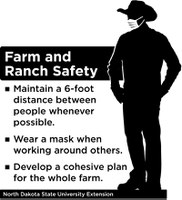Practice Physical Distancing on the Farm/Ranch
(Click the image below to view a high-resolution image that can be downloaded)
As North Dakota slowly moves into a phase of re-opening, the risk of illness from COVID-19 has not faded.
Farmers, ranchers and their employees interact with each other regularly, so they need to follow Centers for Disease Control and Prevention (CDC) physical distancing guidelines to minimize the risk for themselves and their families.
“COVID-19 may be spread by people who are not showing symptoms,” says Lindy Berg, North Dakota State University Extension’s agriculture and natural resources agent in Towner County. “Continue to follow CDC guidelines to keep your workers safe.
“Know which workers are at higher risk of developing serious illness or live with someone at risk and distance them from others as much as possible,” she adds. “Set clear expectations for employees to stay home if they develop symptoms of illness.”
Here are some tips to protect farm employees:
- Maintain a 6-foot distance between people whenever possible.
- Wear a mask when working around others.
- Develop a cohesive plan for the whole farm.
“Set expectations on daily interactions among all employees and what physical distancing measures are to be followed,” advises Angie Johnson, NDSU Extension agriculture and natural resources agent in Steele County. “If employees usually meet at the shop in the morning or the evening before everyone goes home, develop alternatives.”
Daily plans can be communicated virtually through phone calls, emails or group text messages. If in-person meetings are necessary, try to meet outside in an open area rather than in a small shop with limited space that won’t allow for physical distancing. If you have space, set chairs apart or mark spots on the floor for distancing.
“Limit the number of employees working on equipment together in the shop as much as possible,” says Katelyn Hain, NDSU Extension agriculture and natural resources agent for Grand Forks County. “However, keep safety in mind so people are not working alone in hazardous situations without someone to assist or call for help.”
Here are some other tips for physical distancing:
- Have enough vehicles so people can drive separately or in pairs as often as possible. Assign equipment, tractors and pickups to individuals as much as possible, especially for those who may be considered at higher risk of developing illnesses.
- Limit the number of individuals in vehicles when riding from field to field, and wear a mask when sharing this space.
- Limit ride-alongs of nonessential workers or family.
- Stagger breaks and mealtimes to minimize the number of individuals in the breakroom at one time, and encourage cleaning and disinfecting between uses.
Here are some guidelines for livestock producers:
- Call in feed orders and have them charged to your account, then mail the payment. Provide specific directions where bulk feed deliveries should to be unloaded to maintain safe separation.
- Ask your veterinarian or animal health supply store to bring your order out to your vehicle or mail it to you.
- If you are selling livestock, plan on dropping the animals off but not staying to watch the sale.
Visit NDSU’s COVID-19 in agriculture website at https://www.ag.ndsu.edu/farmsafety/covid-19 for more information.
NDSU Agriculture Communication - May 19, 2020
| Source: | Lindy Berg, 701-701-968-4361, lindy.l.berg@ndsu.edu |
|---|---|
| Source: | Angie Johnson, 701-524-2253, angela.b.johnson@ndsu.edu |
| Source: | Katelyn Hain, 701-780-8229, katelyn.hain@ndsu.edu |
| Editor: | Ellen Crawford, 701-231-5391, ellen.crawford@ndsu.edu |


